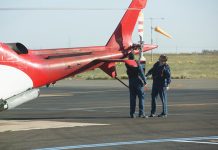The after effects of 2 years of COVID-19 continue in aviation in the form of supply chain difficulties. Is this aviation’s long COVID?
So much for the ‘roaring twenties’. Pandemic and war have reintroduced scarcity to economies around the world after years basking in the luxury of just-in-time supply chains in a global marketplace with one-click delivery. Aviation is no exception.
Running on empty
Analysts believe the transition to a post-lockdown economy will be tougher on aviation suppliers than the lockdown, because this will involve withdrawal of support programs.
Writing in FlightGlobal in September 2022, Jon Hemmerdinger suggested rising interest rates and labour costs were hitting suppliers at time they needed cash to expand. He noted small companies were facing the end of economic assistance plans as well.
‘We believe there are going to be more failures on the ramp up than there [were] on the ramp down,’ Kevin Michaels, managing director of consultancy AeroDynamic Advisory, told Flightglobal.
Alex Krutz, managing director at aerospace and defence advisory Patriot Industrial Partners, noted how many, including ‘small key suppliers’, also received economic assistance in the form of advanced payments from companies higher up the supply chain, such as engine makers and aerostructures manufacturers. Larger firms provided advances so their smaller partners could afford to acquire materials needed to increase production.
But eventually, those advance payments will stop, if they have not already. When that happens, smaller firms might need to weather a period of significantly reduced revenue, Krutz says.
The aerospace industry has been hard hit by the pandemic. Reuters reported aerospace employment in the United States in September 2022 was 8.4 per cent below its pre‑pandemic level.
Delays in small subsectors of the aerospace industry can affect the production of engines and airframes. Reuters quotes a survey by business information specialist Jefferies that found about 75 per cent of aerospace equipment makers cited castings as the largest source of shortages. Business consultants Alixpartners found some casting suppliers are now quoting 18 months to deliver new orders.
You can’t build airplanes without wing spars.
COVID-19 forced some manufacturers to take extraordinary steps to keep production going. CubCrafters of Washington state, US, builds modern light sport aircraft in the style of the immortal Piper Cub. In 2021 the company faced a shortage of aluminium extrusions from its US east coast supplier, which was unable to obtain raw materials. A squad of Cubcrafters employees travelled to Los Angeles to buy aluminium ingots, which they put in the back of a rented truck and drove across the country to their extrusion supplier.
‘You can’t build airplanes without lift struts. You can’t build airplanes without wing spars,’ CubCrafters sales and marketing vice-president Bruce Damm told US AOPA.
In Australia, general aviation and air transport are feeling the effects of the global supply shortage.
Gustav Anderson, CASA principal airworthiness engineer, says the supply chain crisis is multifaceted.
‘It’s not just one element of the supply chain, it’s everything from raw materials, labour shortages, machining, plating,’ he says. ‘It’s complex and, if any elements fall over, it creates a domino effect which ultimately can lead to aircraft being grounded.’
Areas of concern include multifunction displays and piston engines.
‘We’ve heard a lot about chip-related shortages that apply to multifunction displays in helicopters,’ David Punshon, CASA manager of continued operational safety, says ‘Operators are being told the wait for a new display is more than 6 months, which is longer than permissible to remain on a MEL [minimum equipment list].’
Peter Gibbs, CASA senior engineer propulsion and mechanical systems, says piston-engine aircraft operators are encountering shortages of engines and engine components. ‘They are across the board, with engines and cylinders, either new or remanufactured,’ he says ‘Getting supply from the US is proving very difficult and Australian workshops also have long lead times. And there is up to a 12-month lead time for some components.’
Gibbs says the shortage means Australian aircraft operators need to be planning well in advance for maintenance. ‘It’s gone from thinking several weeks in advance, to several months,’ he says.
Structural components have been a concern for some aircraft operators. ‘Late last year, we had 2 agricultural aircraft waiting on replacement wing spars from the US at the same time as the mouse plague in Australia,’ Anderson says. ‘We had to issue 3 service life extensions, with reduced inspection intervals.’
In response to the supply chain squeeze, engine and component makers have published bulletins, notices and extensions, but CASA’s position is that these can not necessarily be taken at face value.
In September 2022, CASA published Airworthiness Bulletin 00-024 Issue 1. The bulletin’s purpose was to clarify the status of ‘no technical objection’ (NTO) statements from aircraft or aeronautical product manufacturers.
An NTO is the generic term for advice provided by a Type Certificate (TC) holder who concurs with an operator’s request for alleviation or variation from airworthiness or operational constraints contained in the aircraft’s maintenance or operational data. It’s what happens when a operator asks the manufacturer, ‘Is it OK to leave out/change/ignore this?’ and the manufacturer or TC holder says, ‘Yes’.
Operators are being told the wait for a new display is more than 6 months, which is longer than permissible to remain on a MEL [minimum equipment list].
The bulletin cautions that an NTO does not constitute automatic approval for variation to approved maintenance data or approved technical data. ‘It remains the operator’s responsibility to ensure that local regulatory approval is obtained before using the manufacturer’s advice, recommendations, alterations, repairs, etc., prescribed in an NTO, technical disposition, or memorandum, as applicable.’
The bulletin goes on to say, ‘A CASA delegate or authorised person asked to approve a change to approved maintenance data or approved technical data, may take an NTO into account. However, when evaluating the compliance of data representing a particular maintenance or alteration action or continued in-service condition, the data must include substantiating data to support an approval.’
The situation may be confusing for operators but Anderson has clear advice. ‘Plan ahead and contact CASA if in doubt. We’re here to assist where we can, but get in touch with us as early as possible.’





